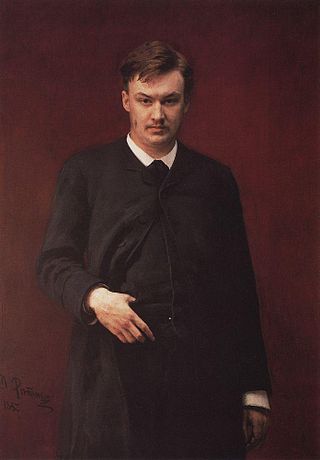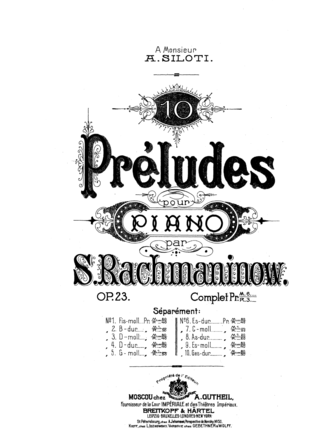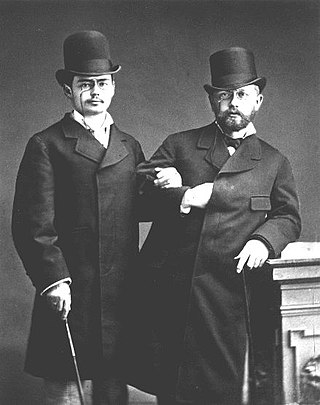
Sergei Vasilyevich Rachmaninoff was a Russian composer, virtuoso pianist, and conductor. Rachmaninoff is widely considered one of the finest pianists of his day and, as a composer, one of the last great representatives of Romanticism in Russian classical music. Early influences of Tchaikovsky, Rimsky-Korsakov, and other Russian composers gave way to a thoroughly personal idiom notable for its song-like melodicism, expressiveness and rich orchestral colours. The piano is featured prominently in Rachmaninoff's compositional output and he made a point of using his skills as a performer to fully explore the expressive and technical possibilities of the instrument.

Alexander Konstantinovich Glazunov was a Russian composer, music teacher, and conductor of the late Russian Romantic period. He was director of the Saint Petersburg Conservatory between 1905 and 1928 and was instrumental in the reorganization of the institute into the Petrograd Conservatory, then the Leningrad Conservatory, following the Bolshevik Revolution. He continued as head of the Conservatory until 1930, though he had left the Soviet Union in 1928 and did not return. The best-known student under his tenure during the early Soviet years was Dmitri Shostakovich.

Anton Stepanovich Arensky was a Russian composer of Romantic classical music, a pianist and a professor of music.

Sergey Ivanovich Taneyev was a Russian composer, pianist, teacher of composition, music theorist and author.

Russian composer Sergei Rachmaninoff's Symphony No. 1 in D minor, his Op. 13, was composed between January and October 1895 at his Ivanovka estate near Tambov, Russia. Despite its poor initial reception, the symphony is now seen as a dynamic representation of the Russian symphonic tradition, with British composer Robert Simpson calling it "a powerful work in its own right, stemming from Borodin and Tchaikovsky, but convinced, individual, finely constructed, and achieving a genuinely tragic and heroic expression that stands far above the pathos of his later music."
Sergei Rachmaninoff composed his Piano Concerto No. 1 in F♯ minor, Op. 1, in 1891, at age 17-18. He dedicated the work to Alexander Siloti. He revised the work thoroughly in 1917.
Wassily Sapellnikoff, was a Ukrainian pianist.

Alexander Sergeyevich Taneyev was a Russian state official and composer of the late Romantic era, specifically of the nationalist school. Among his better-known works were three string quartets, believed to have been composed between 1898–1900.

Suite No. 2, Op. 17, is a composition for two pianos by Sergei Rachmaninoff, written in Italy in the first months of 1901. Alongside his Second Piano Concerto, Op. 18, it confirmed a return of creativity for the composer after four unproductive years caused by the negative critical reception of his First Symphony, Op. 13. The Suite was first performed on November 24 that year by the composer and his cousin Alexander Siloti.
Arseny Nikolayevich Koreshchenko was a pianist and composer of classical music, including operas and ballets. He was from the Russian Empire.

Ten Preludes, Op. 23, is a set of ten preludes for solo piano, composed by Sergei Rachmaninoff in 1901 and 1903. This set includes the famous Prelude in G minor.

The composer Sergei Rachmaninoff produced a number of solo piano pieces that were either lost, unpublished, or not assigned an opus number. While often disregarded in the concert repertoire, they are nevertheless part of his oeuvre. Sixteen of these pieces are extant; all others are lost. Ten of these pieces were composed before he completed his Piano Concerto No. 1, his first opus, and the rest interspersed throughout his later life. In these casual works, he draws upon the influence of other composers, including Frédéric Chopin and Pyotr Tchaikovsky. The more substantial works, the Three Nocturnes and Four Pieces, are sets of well-thought out pieces that are his first attempts at cohesive structure among multiple pieces. Oriental Sketch and Prelude in D minor, two pieces he composed very late in his life, are short works that exemplify his style as a mature composer. Whether completed as a child or adult, these pieces cover a wide spectrum of forms while maintaining his characteristic Russian style.
In classical music, it is relatively rare for a work to be written in collaboration by multiple composers. This contrasts with popular music, where it is common for more than one person to contribute to the music for a song. Nevertheless, there are instances of collaborative classical music compositions.

Sergei Rachmaninoff's Polka de W.R. is a virtuoso piano arrangement of Franz Behr's Lachtäubchen (Scherzpolka) in F major.
The Petite Suite is a suite of seven piano pieces, written by Alexander Borodin, and acknowledged as his major work for the piano. It was published in 1885, although some of the pieces had been written as far back as the late 1870s. After Borodin's death, Alexander Glazunov orchestrated the work, and added his orchestration of another of Borodin's pieces as an eighth number.
Nikolai Vasilievich Artsybushev was a Russian jurist, music publisher and promoter, and minor composer. His name is sometimes seen as Artsibushev, Artsybuchev, Artzibushev, Artzybushev, Artchibousheff, Arcybusev, etc.

The Valse-Scherzo in C major, Op. 34, TH 58, is a work for violin and orchestra by Pyotr Ilyich Tchaikovsky, written in 1877.
The Études-Tableaux, Op. 33, is the first of two sets of piano études composed by Sergei Rachmaninoff. They were intended to be "picture pieces", essentially "musical evocations of external visual stimuli". But Rachmaninoff did not disclose what inspired each one, stating: "I do not believe in the artist that discloses too much of his images. Let [the listener] paint for themselves what it most suggests." However, he willingly shared sources for a few of these études with the Italian composer Ottorino Respighi when Respighi orchestrated them in 1930.

 Play (help·info)
Play (help·info)











